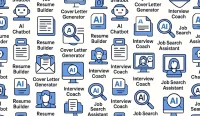In today’s uncertain economic landscape, a comprehensive job market slowdown analysis has become essential for both job seekers and employers. The latest employment report reveals a complex picture: while the economy added 139,000 jobs in May (slightly better than expected), significant layoffs across major corporations and downward revisions of previous months’ figures signal a cooling labor market. This in-depth job market slowdown analysis examines the contrasting trends across industries, wage growth developments, and strategic considerations for navigating this evolving employment environment.
The Reality Behind Recent Employment Numbers
The latest economic data presents a nuanced picture of America’s workforce. This job market slowdown analysis reveals how different sectors are experiencing varying degrees of hiring activity and job losses.
May’s Mixed Employment Signals
While May’s addition of 139,000 jobs exceeded expectations, this job market slowdown analysis identifies concerning trends beneath the headline figure. The unemployment rate remained steady at 4.2%, but significant downward revisions for March and April resulted in 90,500 fewer jobs than previously reported. These adjustments suggest the labor market may be cooling more rapidly than initial reports indicated.
Corporate Layoffs Spreading Across Sectors
“There’s so many companies who are doing layoffs, so if they’re laying people off, then why are they going to hire people?” notes recent advertising graduate Alexis Marquez, capturing the sentiment of many job seekers. This job market slowdown analysis confirms her observation, with major corporations including Microsoft and Procter & Gamble announcing thousands of layoffs recently. The federal government also reduced its workforce by 22,000 positions following the Trump administration’s cuts.
Industry-Specific Growth and Contraction
Not all sectors are experiencing slowdowns. According to employment data analyzed by Bureau of Labor Statistics, healthcare and hospitality (including restaurants and bars) continue to add jobs at a steady pace. This job market slowdown analysis suggests that job seekers may find more opportunities by targeting these growth sectors rather than industries undergoing contraction.
Economic Implications of the Changing Labor Market
The evolving employment landscape has significant implications for the broader economy. This section of our job market slowdown analysis examines how current trends may influence economic policy and business planning.
Federal Reserve’s Cautious Approach
“The economy is slowing down and job growth is slowing down,” notes CBS News business analyst Jill Schlesinger. However, this job market slowdown analysis indicates that the Federal Reserve remains cautious about taking immediate action. The central bank is expected to keep interest rates unchanged at its upcoming meeting, as it waits for clearer signals about the direction of the economy.
The Delicate Balance of Economic Cooling
The Fed faces a challenging balancing act, according to experts at The Economic Policy Institute. “They want to see whether or not the actual economy is slowing down so much that we are going to see job losses, not just slower job creation,” explains Schlesinger. This job market slowdown analysis suggests policymakers are trying to cool inflation without triggering widespread unemployment—a difficult needle to thread.
Corporate Strategy Adjustments
Companies are adapting their hiring strategies in response to economic uncertainty. This job market slowdown analysis reveals that many businesses are implementing hiring freezes rather than layoffs as a first response to slowing growth. According to workforce analysts at SHRM, this approach allows organizations to reduce costs while maintaining operational capacity and employee morale.
Bright Spots in the Labor Market Landscape
Despite overall slowing, this job market slowdown analysis identifies several positive developments for workers and job seekers.
Wage Growth Outpacing Inflation
One highlight in the latest employment report is that wages have increased nearly 4% compared to last year. This job market slowdown analysis notes that workers’ earnings are significantly outpacing the current inflation rate of 2.3%, resulting in genuine increases in purchasing power for many Americans. This trend represents a meaningful improvement in financial conditions for employed workers after several years of inflation-eroded wages.
🚀 Wage Growth is Real — Now’s the Time to Advance
With wages rising nearly 4% year-over-year and inflation holding at just 2.3%, workers are finally seeing true gains in purchasing power.
It’s a great time to level up your career. Explore trending roles in Computer Science, Engineering, Technology, and Research that offer both job security and financial growth.
WhatJobs connects you with high-paying, future-ready jobs to help you make the most of this positive economic shift.
👉 Browse Top Tech and Engineering Jobs NowOpportunities in Resilient Sectors
Healthcare continues to demonstrate remarkable hiring resilience. According to industry experts, this sector added over 30,000 jobs last month alone. This job market slowdown analysis suggests that healthcare’s growth is driven by fundamental demographic factors—particularly an aging population—that remain largely independent of broader economic cycles.
Remote Work Stabilizing
The remote work landscape is evolving from a pandemic necessity to a permanent feature of the employment market. This job market slowdown analysis indicates that companies have largely established their long-term remote work policies, creating more certainty for job seekers with location preferences. According to workplace flexibility researchers, approximately 30% of all work is now performed remotely, representing a new equilibrium that balances employer and employee preferences.
Navigating the Job Market as a Recent Graduate
Recent college graduates face particular challenges in the current environment. This job market slowdown analysis provides specific insights for those beginning their careers.
Industry-Specific Job Hunting Strategies
For graduates like Alexis Marquez, who earned an advertising degree in December but has struggled to find industry employment, this job market slowdown analysis suggests considering adjacent fields that utilize similar skill sets. Marketing analytics, content creation, and digital communication roles often require similar capabilities but may be more abundant in the current market.
Leveraging Internship and Project Experience
Employers are increasingly valuing practical experience over academic credentials alone. This job market slowdown analysis recommends that recent graduates highlight internships, class projects, and portfolio work prominently in applications. According to hiring managers surveyed by National Association of Colleges and Employers, demonstrated skills and accomplishments significantly increase candidacy strength, especially in a competitive market.
Geographic Flexibility Advantages
Location flexibility can substantially improve job prospects. This job market slowdown analysis indicates that job markets vary significantly by region, with some metropolitan areas maintaining robust hiring despite the national slowdown. Graduates willing to relocate may find substantially more opportunities than those limited to a single location.
Consider these strategic approaches:
- Target industries showing growth despite the overall slowdown
- Develop in-demand skills that transcend economic cycles
- Build a recession-resistant personal brand
- Explore flexible work arrangements including remote and hybrid options
- Consider geographic relocation to stronger job markets
📉 Hiring Despite the Slowdown?
Even in a cooling job market, many organizations still need skilled, driven professionals to move forward. If you’re recruiting during this period of economic uncertainty and shifting workforce dynamics, reaching the right candidates quickly is more important than ever.
WhatJobs helps you connect with job seekers who are motivated, market-aware, and actively looking for stable opportunities with forward-thinking employers.
👉 Post Jobs for Free with WhatJobsLooking Ahead: Job Market Trajectory
While current indicators point to a cooling labor market, this job market slowdown analysis suggests the situation is far from a crisis. The combination of moderate job growth, strong wage increases, and sector-specific opportunities creates a complex but navigable employment landscape.
As CBS News business analyst Jill Schlesinger notes, we’re currently seeing “slower job creation” rather than widespread “job losses.” This distinction is crucial for both job seekers and employers. The economy continues to add jobs, albeit at a reduced pace, indicating that opportunities remain available even as competition for them intensifies.
For workers, employers, and policymakers alike, continued monitoring of employment trends will be essential. This job market slowdown analysis represents a snapshot of current conditions, but the dynamic nature of the economy means that new developments may shift the landscape in the coming months.
FAQ About Job Market Slowdown Analysis
What sectors are still growing according to recent job market slowdown analysis?
According to current job market slowdown analysis, healthcare and hospitality (including restaurants and bars) continue to show strong hiring activity despite the broader economic slowdown. These sectors appear to be more resilient to current economic pressures, with healthcare in particular benefiting from long-term demographic trends that drive demand regardless of economic cycles. Job seekers may find more abundant opportunities by focusing their search on these growth areas rather than industries experiencing contraction.
How is wage growth trending according to job market slowdown analysis?
Recent job market slowdown analysis reveals a positive trend for workers: wages have increased by nearly 4% compared to last year, significantly outpacing the current inflation rate of 2.3%. This means that, on average, workers are experiencing real gains in purchasing power after several years of inflation-eroded wages. This wage growth represents one of the few bright spots in the current employment landscape and provides some financial relief for those who remain employed during this period of economic uncertainty.
What challenges do recent graduates face based on job market slowdown analysis?
Current job market slowdown analysis indicates that recent college graduates like Alexis Marquez are entering a particularly challenging labor market. With major corporations announcing layoffs and many companies implementing hiring freezes, competition for entry-level positions has intensified. Graduates in industries experiencing contraction may need to consider adjacent fields, develop specialized skills that remain in demand despite the slowdown, or demonstrate flexibility regarding location and compensation to improve their employment prospects in this difficult environment.
How is the Federal Reserve responding to job market slowdown analysis?
According to the latest job market slowdown analysis, the Federal Reserve is taking a cautious approach despite clear signs of cooling in the labor market. The central bank is expected to keep interest rates unchanged at its upcoming meeting as it carefully monitors whether the economy is “slowing down so much that we are going to see job losses, not just slower job creation.” This deliberate approach reflects the delicate balance the Fed is trying to maintain: cooling inflation without triggering widespread unemployment that could lead to a more severe economic downturn.
What industries are experiencing the most layoffs according to job market slowdown analysis?
Current job market slowdown analysis identifies several sectors experiencing significant workforce reductions. Technology companies like Microsoft have announced thousands of layoffs, while consumer goods manufacturers such as Procter & Gamble are also reducing their workforces. Additionally, the federal government has cut 22,000 jobs following the Trump administration’s reduction initiatives. These patterns suggest that industries facing technological disruption, consumer spending shifts, or budget constraints are most vulnerable to continued workforce reductions in the current economic environment.
How does the current job market compare to pre-pandemic levels based on job market slowdown analysis?
Job market slowdown analysis comparing current employment data to pre-pandemic benchmarks reveals a complex picture. While the overall unemployment rate of 4.2% remains historically low, job creation has slowed significantly from the rapid pace of the post-pandemic recovery. The recent downward revisions of previous months’ employment figures suggest the labor market may be cooling more rapidly than initially reported. However, certain structural changes—particularly the establishment of remote and hybrid work arrangements—represent permanent shifts rather than cyclical changes, creating new opportunities alongside traditional employment patterns.




